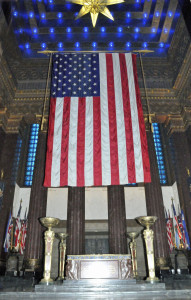In 1920, as part of a successful plan to lure the American Legion headquarters to Indianapolis, the Indiana General Assembly appropriated $2 million for a monument to the victors of the recent world war. General John J. Pershing broke ground for the 210-feet-tall War Memorial in 1927, which was dedicated in 1933 even though the interior remained incomplete despite additional funding from the Works Progress Administration.
The design of the three-story square building, with columns and pyramid-shaped roof, evokes the tomb of Mausolus, a wonder of the ancient world that gave us the word “mausoleum.” Words carved in the limestone exterior express hope the building will “inspire patriotism and respect for the laws to the end that peace may prevail, justice be administered, public order maintained and liberty perpetuated.”
The building’s surprisingly capacious interior, making extensive use of marble, includes a 500-seat auditorium, meeting rooms and a museum of military history. The inspiring Shrine Room on the third floor honors the soldiers who won the “war to end all wars.” Incorporating materials from all the Allies, the room features a huge American flag hanging vertically over an “Altar of Consecration.” The altar is surrounded by 24 fluted columns of dark red Vermont marble. High above the altar are blue lights and a crystal “Star of Destiny” from Sweden. Wall paintings depict the leading Allied soldiers. Marble stairways to the Shrine Room contain the names of all Hoosiers who served in World War I.
The Indiana War Memorial garnered national attention in 1953 when Edward R. Murrow’s popular “See it Now” television series covered the American Legion’s controversial closing of the auditorium to the Indiana Civil Liberties Union. Those days are long gone and the building is open to the public Wednesdays to Sundays from 9 am to 5 pm. The next time you long to visit a world-class building, consider a trip to 431 North Meridian.
